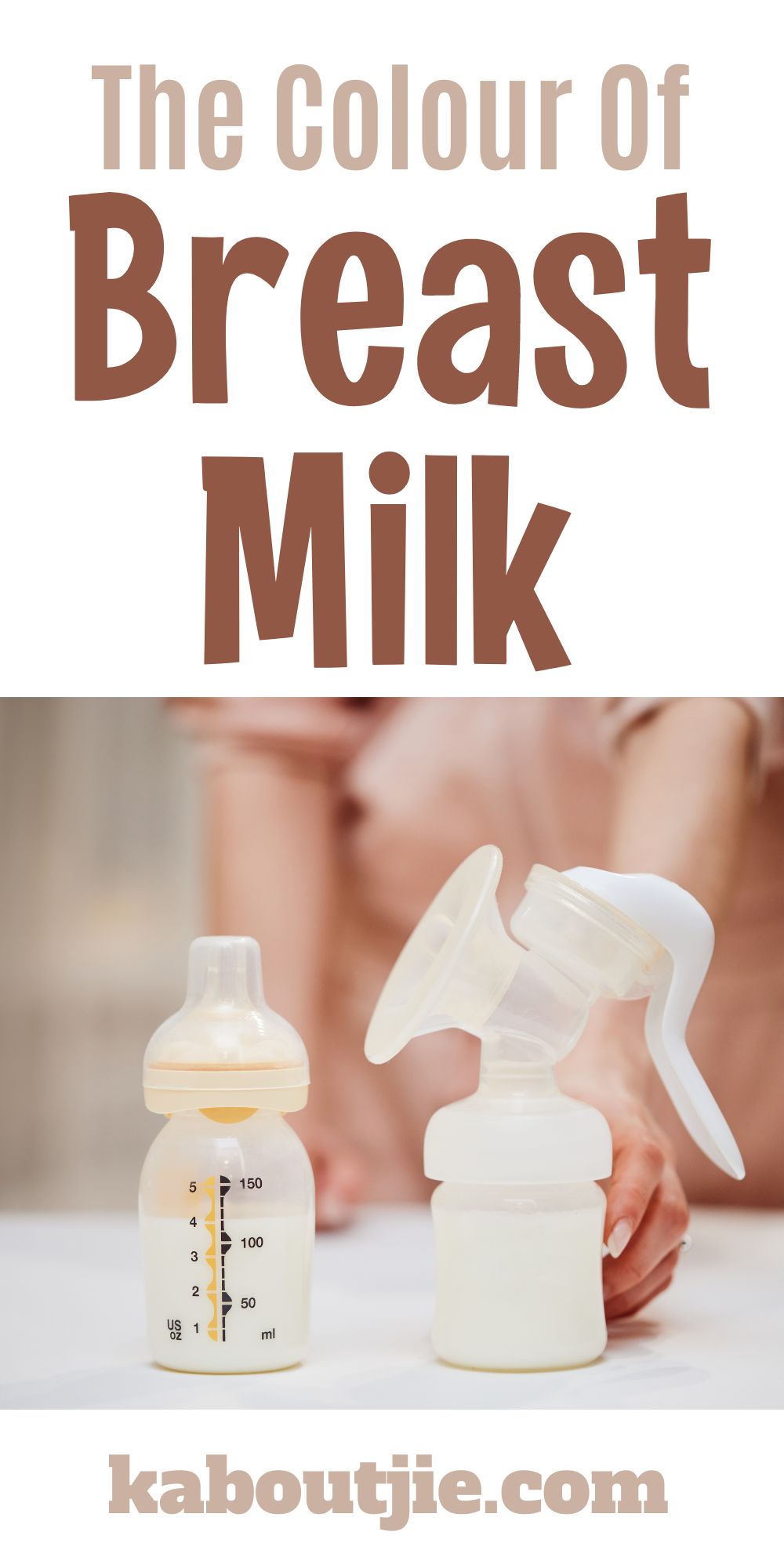When it comes to caring for your baby, you will need to make sure he’s fed with healthy breast milk for him to gain weight and grow. While breast milk is all natural, there will be times that it has different colours, and that may cause new moms to worry!
One common question mothers ask would be: “What colour is breast milk?”
If you’re wondering what healthy breast milk looks like, as well as the different colours of milk and what it indicates, read on as we show you everything you need to know! We also give you tips on how to maintain healthy breast milk to help you out.
***Disclosure -The links in this post may contain affiliate links and I may receive a small commission if you make a purchase after clicking on a link.***

What Colour Is Breast Milk?
Normally, the colour of your breast milk should be clear, blue, or white.
Don’t be suspicious when you see a bluish colour and thin consistency! It’s a bit blue in colour once you begin pumping or feeding your baby, but after a few minutes, it turns into a clear or white colour.
The blue or transparent colours are called the foremilk, which is thinner, thus with little fat content. As you continue to nurse or pump breast milk, the fat content increases. The milk with higher fat content is called hindmilk, which is creamier and whiter.
But the colour depends on a few factors, such as your diet or lifestyle.
The Different Colours of Breast Milk And What It Means
Breast milk can be in various colours, depending on your diet and the supplements you take in. Here are the different colours your breast milk may have:
Green
Your breast milk may be green after you take in green food or those that contain green dye, such as spinach or green-coloured juices.
Pink, Orange or Red
If you have red-tinged breast milk that doesn’t have blood, then it may be from similar-coloured food, usually yellow or orange. Examples would be eating beets or soda and fruits that are either red, yellow, or orange.
Blood, Rusty or Brown
If ever your breast milk begins to look brown or rusty, then it may be of blood coming from inside your breasts or cracked nipples. This is still safe and will disappear in a few days. If it doesn’t after a week, then consult a doctor.
Black
Black breast milk comes from using mincing, an antibiotic that causes your skin to darken, and may affect your breast milk production as well. This medicine is not recommended to take while nursing, so ask your doctor regarding the medication you are and should be taking while nursing.
You won’t need to worry about the changes of breast milk colour unless you begin to feel feverish. But if you have your suspicions, then you can contact your doctor for advice on what you should change in your diet.
Stages Of Breast Milk
Breast milk doesn’t come out looking like milk immediately. You go through three stages of producing breast milk, beginning with pregnancy.
Colostrum
This is the first type of milk you produce, starting during pregnancy. It will last for a few days after giving birth. During this stage, your milk looks yellowish and creamy, also thicker than the milk you will begin to produce when breastfeeding.
Colostrum has high levels of proteins and minerals, which is essential for your newborn baby as his immune system begins to improve.
Transitional Milk
This type of milk would last for about two weeks, containing more fat, lactose, and other forms of vitamins. It has more calories compared to colostrum.
Mature Milk
The final stage, this type of milk is 90% water and 10% of the required macronutrients to keep your baby energized and well. That means it has a thinner consistency compared to the first two stages.
This phase will last until your baby doesn’t need to be breastfed and starts eating solids or another type of milk.
What Does Healthy Breast Milk Look Like?
Like mentioned, healthy breast milk would appear bluish or clear in colour at first, then become a more creamy and whiter look.
But again, you will need to take account the supplements and food you take in, as the colour varies.
If ever you are feverish or your breast milk looks odd, such as containing pus or drastic change of colour, then there might be something wrong with your breast milk and production.
Consult a doctor immediately to prevent any health issues that may happen to you or your baby. It’s always best to seed advice from medical professionals if there is any cause for concern.

How To Make Breast Milk More Nutritious
Now that you know what breast milk should look like and the colours it may be, the next question is: How can you make it more nutritious and healthier for your baby?
To maintain the nutritional value of your breast milk, here are some diet tips to follow:
Calorie Intake
It’s recommended to increase your calorie intake by about 500 calories a day to maintain your energy levels. Don’t consume over that range, or it will prevent you from losing the post-pregnancy weight, an important part when you begin to recover from pregnancy.
Protein
You can also follow your diet while you were pregnant. Just make sure that the calories you take in are filled with nutritious and protein-rich food, such as lean meat, dairy, or beans.
Liquid
Do not take in over three cups of caffeinated beverages a day, as the caffeine enters the breast milk and can make your baby fussy. Also, avoid alcohol as much as possible. If you do drink alcohol, wait for it to clear out of our system before breastfeeding again.
In Conclusion
Breast milk is an essential for your baby, and just like how grown people eat, you must make sure he’s taking in nutritious breast milk for him to grow into a healthy child. That’s why it’s critical to know what colour breast milk is, as well as how you can produce healthy and regular breast milk for your baby.
Hopefully, this article answers your question: “What colour is breast milk?” Now, you’ll be able to follow the tips to maintain the standard colour and constancy of breast milk.
If you have any questions or opinions about the colour of breast milk, then comment down below. We would love to hear what you have to think.
 I am Lily Hayes, a writer and teacher by profession who firmly believes that motherhood is the fulfilling experience we can ever have in this world and founder of TheBabyLands.com. I have spent years being an expert in what I do. I love my job immensely because I love to share and create things that will have a big impact on people. In fact, I have already written various e-books about self-development and parenting. Follow me on Twitter @TheBabyLandsCom
I am Lily Hayes, a writer and teacher by profession who firmly believes that motherhood is the fulfilling experience we can ever have in this world and founder of TheBabyLands.com. I have spent years being an expert in what I do. I love my job immensely because I love to share and create things that will have a big impact on people. In fact, I have already written various e-books about self-development and parenting. Follow me on Twitter @TheBabyLandsCom
 Kaboutjie SA Mommy Blogs by Lynne Huysamen
Kaboutjie SA Mommy Blogs by Lynne Huysamen







Hi Lily, really enjoyed your post. Shooee, I’d be seriously worried if my breast milk came out black. I didn’t know about the initial bluish look of the milk. Good to know it’s perfectly normal, as I’ll be expressing my breast milk for the first time in the next couple of days, after breastfeeding my son for 3 and a half years. Hoping to be able to eke out a few drops so I can have a breast milk pendant made by Precious Mammaries at yourbreastmilk.com
Yes I did see my breast milk had a blue tint to it when I expressed those few times! It was strange for sure @happyhumanpacifier.
Good luck getting that milk out!
Thanks for your encouragement @lynne
xxx
@lynne wasn’t you scared?
@vhutshiloali1 of the blue tint? Well it is only slightly blue not like bright blue 🙂 Nope it looked ok, it wasn’t scary or anything but I could see it wasn’t cows milk!
Ok that’s a relief
First time I knew that breastmilk has so many different colours… Wow I’m been educated more and more. Thank you for this information.
OMGI never knew that the breast milk have so many colors thank you otherwise if I see my breast milk coming out in blue or black I would ran to the doctor.
I never knew that even breastmilk can be different colours thank for sharing
Hi @lynne does kaboutjie have an app?
Nope we don’t have an app @vhutshiloali1 in fact I have never thought about it… imagine… but I wouldn’t have a clue how to get one! It is certainly something to think about though.
Ok @lynne I was wondering. It’s could nice though
I noticed my breast milk didn’t look the same as cows milk or formula. Yes it had a blueish tinge but it was more like it was not as fatty or thick so it was more translucent looking.
This was really interesting, especially the explanation of what every colour means.
Had no idea about the bluish colour.
This has been really informative – I also notice the change in colour when I’m not feeling so well (the milk gets darker and creamier looking) It’s really interesting how our bodies know just what to do to feed the little ones exactly what they need!
Amazing stuff.
Wow I did not know this, Thanks for sharing
I didn’t know that breast milk has so much colours.Thanks for the information
I didn’t know that breast milk had different colors. You k ow I never had colostrum during my pregnancy. Which I think is the cause as to why I struggled with producing milk. Do you have any ideas how to combat that in future
I would think the best would be to speak to a lactation consultant or perhaps someone at La Leche League if you are worried about it if you have another baby.
Amazing thank you for this I never knew that there were different colors in breastmilk this article was very informative and interesting.
I’ve learn so much from your post and it’s just shows us how important breast milk is to any baby